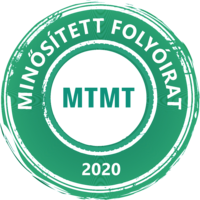Water footprint: A new approach for a more sustainable future
DOI:
https://doi.org/10.14232/analecta.2019.2.12-20Keywords:
water management, water footprint, blue water, green water, gray waterAbstract
Sustainability of water use has got into focus recently, as availability of fresh water resources is under depletion. Population growth, extreme weather conditions (drought), increasing global meat demand all results in higher water consumption of humanity and ecosystem. Water footprint is a promising indicator, which assesses both qualitative and quantitative deterioration of fresh water supplies. By identifying blue, green and grey water components, water use can be assessed in a more comprehensive way.
Furthermore impact assessment of different components during production and processing let us identify crucial points of water use, where more efficient solution should be found. As a consequence of a more conscious and sustainable water use assessment considering water footprint, there is a chance, that future generations will inherit fresh water supplies at least in the same condition as we got it from our ancestors.
Downloads
References
2. Allan, J.A. 1993. “Fortunately there are Substitutes for Water Otherwise our Hydro-political Futures would be Impossible.” In Priorities for Water Resources Allocation and Management. London, United Kingdom: ODA: 13–26
3. Bayart, JB., Bulle, C., Deschênes, L. et al.2010, A framework for assessing off-stream freshwater use in LCA, Int J Life Cycle, 15: 5, pp 439–453. Available at: https://doi.org/10.1007/s11367-010-0172-7, Accessed at 08/06/2018.
4. Borsato, E., Tarolli, P., Marinello, F., 2018, Sustainable patterns of main agricultural products combining different footprint parameters, Journal of Cleaner Production,vol.179, pp.357-367.
5. Boulay AM1, Bulle C, Bayart JB, Deschênes L, Margni M., 2011, Regional Characterization of Freshwater Use in LCA: Modeling Direct Impacts on Human Health, Environ. Sci. Technol., 45 (20), pp 8948–8957
6. Boulay, AM., Bare, J., Benini, L. et al. Int J Life Cycle Assess (2018) 23: 368. Available at: https://doi.org/10.1007/s11367-017-1333-8 , Accessed: 17/12/2018.
7. Bulsink, F., Hoekstra, A., Booij, M.J., 2010. The water footprint of Indonesian provinces related to the consumption of crop products. Hydrol. Earth Syst. Sci. 14, 119–128.
8. Chapagain, a K., Hoekstra, a Y., 2004. Volume 1: Main Report. Main 1, p. 80. https://
doi.org/10.5194/hess-15-1577-2011.
9. Falkenmark, M., Lannerstad, M., 2007. Consumptive water use to feed humanity—curing a blind spot. Hydrol. Earth Syst. Sci. 9, 15–28.
10. FAO, 2011. The State of the World's land and water resources for Food and Agriculture. Managing systems at risk. Food Agric. Organ. https://doi.org/978-1-84971-326-9.
11. Galli, A., Wiedmann, T., Ercin, E., Knoblauch, D., Ewing, B., Giljum, S., 2012. Integrating ecological, carbon and water footprint into a “footprint family” of indicators: definition and role in tracking human pressure on the planet. Ecol. Indic. 16, 100–112, http://dx.doi.org/10.1016/j.ecolind.2011.06.017.
12. Glavan, M., Pintar, M., Volk, M., 2012. Land use change in a 200-year period and its effect on blue and green water flow in two Slovenian Mediterranean catchments—lessons for the future. Hydrol. Process., http://dx.doi.org/10.1002/hyp.9540.
13. Hastings, E., Pegram, G., 2012. Literature Review for the Applicability of Water Footprints in South Africa, WRC Report No. 2099/P/11, Water Research Commission, Gezina, South Africa.
14. Hoekstra, A.Y., 2011. How sustainable is Europe’s water footprint? Water Waste water Int. 26, 24–26.
15. Hoekstra, A.Y., Chapagain, A.K., Aldaya, M.M., Mekonnen, M.M., 2011. The Water Footprint Assessment Manual, London…:? book
16. Hoekstra, A.Y., Hung, P.Q., 2002. A quantification of virtual water flows between nations in relation to international crop trade. Water Res. 49, 203-209.
17. Hoekstra, Arjen Y., 2012 The hidden water resource use behind meat and dairy, Available at: https://waterfootprint.org/media/downloads/Hoekstra-2012-Water-Meat-Dairy.pdf , Accessed:13/12/2018.
18. IDF, 2017. Available at: https://www.fil-idf.org/wp-content/uploads/2017/08/2017_01_31_The-IDF-Guide-to-Water-Footprint-Methodology-for-the-Dairy-Sector-_Press-Release.pdf accessed 26/11/2018.
19. ISO 14046, Avalible at: https://www.iso.org/obp/ui/#iso:std:iso:14046:ed-1:v1:en , Accessed 26/11/2018.
20. Liu, J., Savenije, H.H.G., 2008. A) Food consumption patterns and their effect on water requirement in China. Hydrol. Earth Syst. Sci. 12, 887–898.
21. Mekonnen, M.M., Hoekstra, A.Y., 2011a. Value of Water Research Report Series No.50. National Water Footprint Accounts: the Green, Blue and Grey Water Footprint of Production and Consumption, vol. 1. UNESCO-IHE, Delft, The Netherlands, pp. 1-50.
22. Mekonnen, M.M., Hoekstra, A.Y., 2011b. The green, blue and grey water footprint of crops and derived crop products. Hydrol. Earth Syst. Sci. 15, 1577-1600. https:// doi.org/10.5194/hess-15-1577-2011.
23. Pfister, S., Bayer, P., 2014. Monthly water stress: Spatially and temporally explicit consumptive water footprint of global crop production. J. Clean. Prod. 73, 52e62. https://doi.org/10.1016/j.jclepro.2013.11.031.
24. Ridoutt BG, Pfister S (2010)a A revised approach to water footprinting to make transparent the impacts of consumption and production on global freshwater scarcity. Glob Environ Change 20: 113-120
25. Rockström, J., Falkenmark, M., Karlberg, L., Hoff, H., Rost, S., Gerten, D., 2009. Future water availability for global food production: the potential of green water for increasing resilience to global change. Water Resour. Res. 45, W00A12, Available at: http://dx.doi.org/10.1029/2007WR006767., Accessed 26/11/2018.
26. Shiklomanov, I. A.: Appraisal and Assessment of World Water Resources, Water Int., 25(1),11–32, 2000.
27. Sonnenberg, A., Chapagain, A., Geiger, M., August, D., 2009. The Water Footprint of Germany—Where Does the Water Incorporated in our Food Come From? WWF Germany, Frankfurt am Main (in German).
28. UNDP: Human Development Report 2006 – Beyond Scarcity: Power, Poverty and the Global Water Crisis, New York, United Nations Development Programme, 422 pp., 2006.
29. UNEP, 2012. Measuring Water Use in a Green Economy. A Report of the Working Group on Water Efficiency to the International Resource Panel, McGlade, J., Werner, B., Young, M., Matlock, M., Jefferies, D., Sonnemann, G., Aldaya, M., Pfister, S., Berger, M., Farell, C., Hyde, K., Wackernagel, M., Hoekstra, A., Mathews, R., Liu, J., Ercin, E., Weber, J.L., Alfieri, A., Martinez-Lagunes, R., Edens, B., Schulte, P., von Wirén-Lehr, S., Gee, D.
30. UNIS, 2019, Sustainable development goals, available at:http://www.unis.unvienna.org/unis/hu/topics/sustainable_development_goals.html , Accessed: 13/01/2019
31. UN-Water. 2007. Coping with water scarcity: challenge of the 21st century. Available at:http://www.fao.org/nr/water/docs/escarcity.pdf. Accessed 16 May 2013,
32. Van Oel, P., Mekonnen, M., Hoekstra, A., 2009. The external water footprint of the Netherlands: geographically-explicit quantification and impact assessment. Ecol. Econ. 69, 82–92.
33. Vanham, D. and Bidoglio, G., 2013, A review on the indicator water footprint for the EU28, Ecological Indicators vol26 , pp. 61–75
34. Vanham, D., 2012. A holistic water balance of Austria—how does the quantitative proportion of urban water requirements relate to other users? Water Sci. Technol. 66, 549–555, http://dx.doi.org/10.2166/wst.2012.201., Accessed at 08/06/2018
35. Verma, S., Kampman, D.A., van der Zaag, P., Hoekstra, A.Y., 2009. Going against the flow: a critical analysis of inter-state virtual water trade in the context of India’s National River Linking Program. Phys. Chem. Earth 34, 261–269
36. Wackernagel, M. and Rees, W. (1996), Our Ecological Footprint: Reducing Human Impact on the Earth, New Society Publishers, Gabriola Island, BC, Canada
37. Willaarts, B.A., Volk, M., Aguilera, P.A., 2012. Assessing the ecosystem services supplied by freshwater flows in Mediterranean agroecosystems. Agric. Water Manage. 105, 21–31.
Downloads
Published
How to Cite
Issue
Section
License
Copyright (C) 2024 Authors
This work is licensed under a Creative Commons Attribution 4.0 International License.













